Things to know about the :nth-child() selector in CSS
:nth-child() in CSS is especially useful in styling complex tables and lists. Here's what you need to know about :nth-child() in CSS .

Like all CSS selectors, you can use :nth-child() to identify elements in a web page and apply different styles to them. But this selector allows you to narrow down a group of factors based on their relative position.
This selector supports some basic keywords for common cases. Additionally, it also provides powerful pattern matching syntax. Using it, you can select components based on regular patterns, repetitions, or complex definitions according to your needs.
:nth-child() selector syntax
Although it is a CSS pseudo-class selector, the :nth-child() syntax is different from other selectors. It takes a template argument to combine elements in a child element group:
:nth-child(args) { /*.*/ }The main focus is on the arguments in parentheses. These arguments specify the subset of elements to select.
Use keyword values for common cases
This selector can contain two keyword values: odd and even . They are especially useful for styling alternate table rows.
A simple ordered list is another good example of when you can use these keyword values:
- Item 1
- Item 2
- Item 3
- Item 4
- Item 5
- Item 6
- Item 7
Using the :nth-child(odd) selector , you can change the color of each replacement item:
:nth-child(odd) { color: red; }Items start at index 1, so the first item will appear in red, then the third. so on and so forth:

More flexibility using function notation
You can use a single integer to select a single element, like this:
li:nth-child(4) { color: red; }In this case, the selector combines only the 4th item in the list:
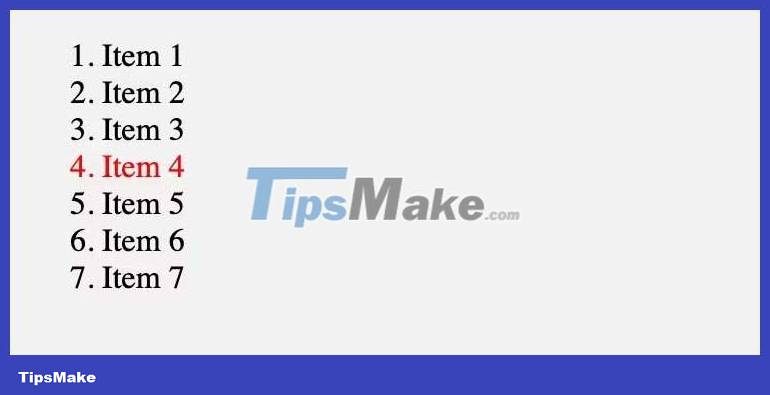
This syntax is a special case of the more general functional syntax that selects items that match a certain pattern. This syntax is:
:nth-child(An+B) { /*.*/ }In this notation, A is the step size. This means the number of times the selector moves to select the next item. It allows you to select every other item, every third item, etc. B is the starting point of selection.
For example, take the argument 3n+1 :
li:nth-child(3n+1) { color: red; }This will start the selection at the first item and continue with every third item after that:
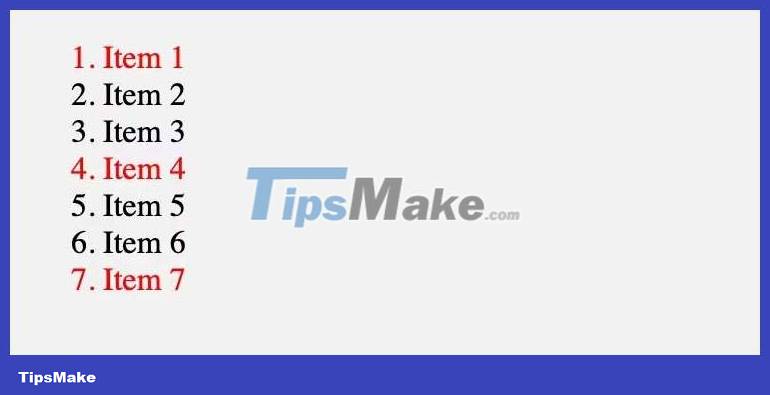
Compare it with the expression 3n+2:
li:nth-child(3n+2) { color:red; }This action still selects every third item, but now it starts from the second item in the list:
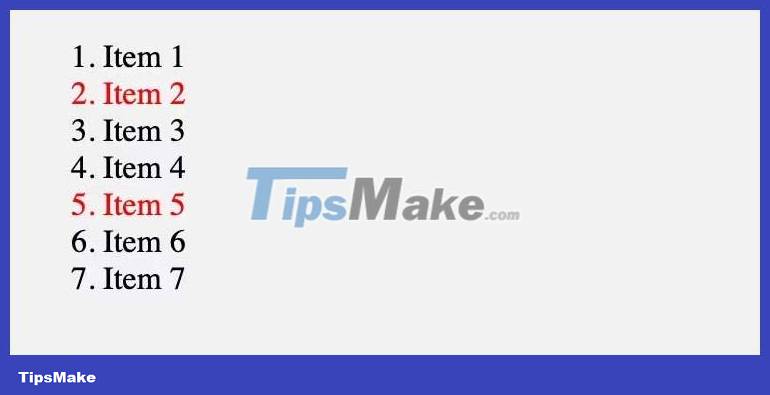
Another interesting example is :nth-child(n+3):
li:nth-child(n+3) { color: red; }This code will select each item (n), starting from the third (+3). It will look like this.
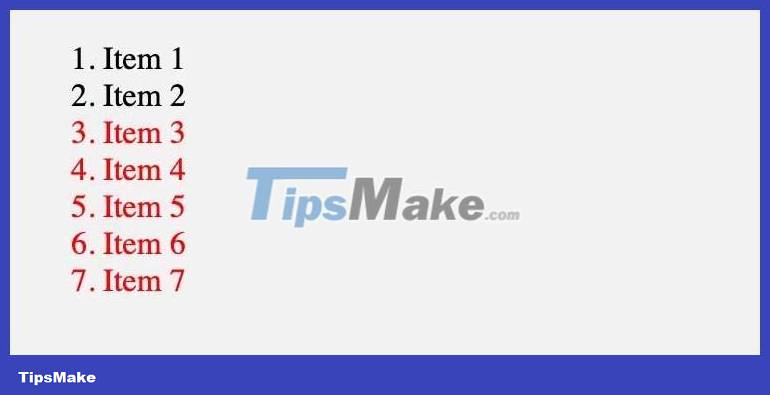
You can also use subtraction to achieve certain results:
li:nth-child(3n-1) { color: red; }This example still selects every third item, but it starts from the 'first minus sign'. In practice, this means it will pick the second item in the list, then the fifth, etc.:
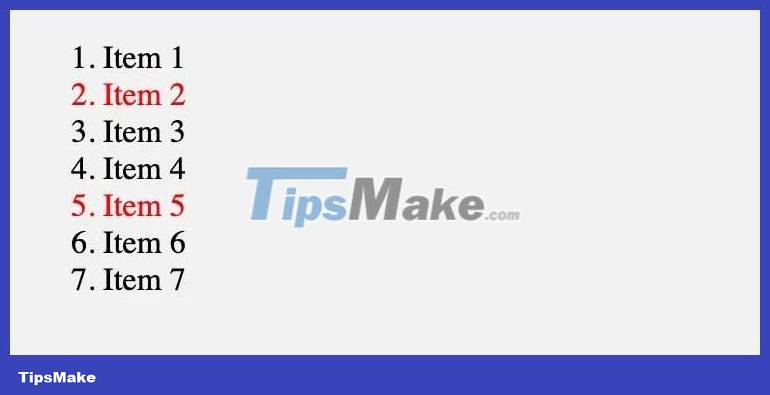
Syntax of
You can also use the of keyword followed by a selector as an argument in the :nth-child() selector. This syntax allows you to narrow down the possible items that the regular pattern selects from.
For example, imagine your markup is more complex than the original:
- Item 1
- Item 2
- Item 3
- Item 4
- Item 5
- Item 6
- Item 7
Now, use :nth-chilNow, use :nth-child to select even items from the set of items with a specific class:
.new { font-weight: bold; } li:nth-child(even of.new) { color: red; }Note that only even-numbered bold items are red:
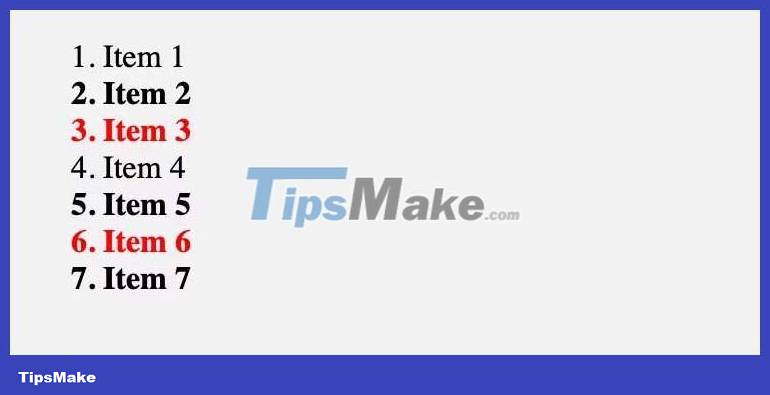
Also consider the difference with li.new:nth-child(even) which targets .new elements, but only if they are even. These would be items 2 and 6 in the example above.
Above are the things you need to know about using the :nth-child() selector in CSS. Hope the article is useful to you.
You should read it
- Set of multiple choice questions for programming with P15 prize
- Set of multiple choice questions about programming with P10 prize
- Set of multiple choice questions about programming with P7 prize
- Set of multiple-choice questions on award-winning programming P5
- Set of multiple choice questions about programming with P6
- P13 programming set of multiple choice questions
- Set of multiple choice questions on programming with P3 prize
- Set of multiple choice questions on programming with P16 prize
May be interested
- How to Prepare Your Child for Middle School
 it can be daunting for you and for your child when your child heads to middle school. the school will be bigger, full of new students and teachers, and your child will go from being one of the oldest kid in school to one of the youngest....
it can be daunting for you and for your child when your child heads to middle school. the school will be bigger, full of new students and teachers, and your child will go from being one of the oldest kid in school to one of the youngest.... - 5 best child monitoring apps for mobile phones
 today many families give their phones to their children as a trend of the times. but can you trust your child to use the phone only for emergency calls and for good reasons?
today many families give their phones to their children as a trend of the times. but can you trust your child to use the phone only for emergency calls and for good reasons? - App scan feet to buy standard Vietnamese shoes
 just download the app and install it on your smartphone, scan fit will give you details of the numbers about your feet. from there, you can rest assured to order shoes without going to the store.
just download the app and install it on your smartphone, scan fit will give you details of the numbers about your feet. from there, you can rest assured to order shoes without going to the store. - First aid methods for children
 these basic first aid measures at the beginning will help children a lot in saving their lives and treating them later.
these basic first aid measures at the beginning will help children a lot in saving their lives and treating them later. - How to quickly translate Vietnamese English on iPhone
 tweak selector will translate vietnamese english quickly on jailbroken ios devices.
tweak selector will translate vietnamese english quickly on jailbroken ios devices. - How to use the most simple, detailed child locator Q50
 equipped with a positioning clock is a very necessary job to help parents feel secure to work, go to work away from home and still monitor their children's activities. in this article, quantum will guide you how to use the positioning clock q50 - one of the products most trusted by parents today.
equipped with a positioning clock is a very necessary job to help parents feel secure to work, go to work away from home and still monitor their children's activities. in this article, quantum will guide you how to use the positioning clock q50 - one of the products most trusted by parents today. - Things parents should not do for their children
 parents' task is to help their children grow up and gain experience for a better life. here are the things parents should never do for their children.
parents' task is to help their children grow up and gain experience for a better life. here are the things parents should never do for their children. - How to Communicate with a Child's Middle School Teacher
 there can be many reasons for wanting to communicate with a middle school teacher. this could range from your child experiencing hardship in learning to wanting to check in on your learner's progress. communicating effectively requires...
there can be many reasons for wanting to communicate with a middle school teacher. this could range from your child experiencing hardship in learning to wanting to check in on your learner's progress. communicating effectively requires... - How to Take Action when You Lose Sight of Your Child at an Amusement Park
 it's a scenario that happens hundreds of times a day at amusement parks all across the world. you're walking along with your family or group, young child in hand, but when you look down a minute later, alas, he or she is gone! you suspect...
it's a scenario that happens hundreds of times a day at amusement parks all across the world. you're walking along with your family or group, young child in hand, but when you look down a minute later, alas, he or she is gone! you suspect... - How to predict your child's face in the future
 can you get child face now? is an app to predict your child's face on iphone very interesting. you will know what the face of a boy and a girl will look like through a picture of a parent.
can you get child face now? is an app to predict your child's face on iphone very interesting. you will know what the face of a boy and a girl will look like through a picture of a parent.










 How to use Spotify's Jam feature to create playlists from many people
How to use Spotify's Jam feature to create playlists from many people What changes does iPhone 15 have compared to iPhone 14?
What changes does iPhone 15 have compared to iPhone 14? How to install and run Arduino IDE on Raspberry Pi
How to install and run Arduino IDE on Raspberry Pi Should I buy a custom or pre-built mechanical keyboard?
Should I buy a custom or pre-built mechanical keyboard? Is Fitbit's heart rate monitor accurate?
Is Fitbit's heart rate monitor accurate? What is No-Code AI and how to use No-Code AI
What is No-Code AI and how to use No-Code AI